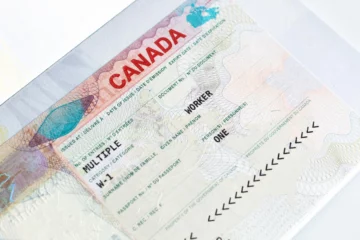Some employers have to obtain a Labour Market Impact Assessment (“LMIA”) before they can hire a foreign worker to work for them.
A positive LMIA demonstrates that there is a need for foreign workers to fill a position as there are no Canadian citizens or permanent residents available for the job. In this article, we will discuss the process for obtaining an LMIA work permit, the LMIA application requirements for both applicants and employers, the Transition Plan for hiring a Temporary Foreign Worker (TFW), the recruitment efforts required by the TFW program, and wage expectations.
Table of contents
What is LMIA in Canada?
An LMIA is a document obtained by an employer in Canada before hiring foreign workers. A positive LMIA result demonstrates a need for foreign workers to fill a position for that job, as there are no permanent residents or Canadian citizens available to perform the job.
The Process for an LMIA Work Permit
The first step is for the employer to apply to get an LMIA, which will then allow the worker to apply for a work permit. This will demonstrate to the Government of Canada that there are no Canadian citizens or permanent residents available to do the job and that the position needs to be filled by a TFW. The second step is for the TFW to apply for an employer-specific work permit. To apply, a worker needs an offer of employment letter, the job contract, a copy of the employer’s LMIA, and the LMIA number.
There are two types of work permits: employer-specific work permits and open work permits. The LMIA is used for employer-specific work permits. An employer-specific work permit allows you to work in Canada under specified conditions such as the name of the specific employer you can work for, the period for which you can work, and the location (if applicable) where you can work.
LMIA Application Requirements for Applicants and Employers
The processing fee for applying for a work permit in Canada starts from $155. Processing time varies by the country from which you are applying for the work permit. To be eligible, you need to demonstrate to an officer working for Immigration, Refugee, and Citizenship Canada that:
- You will leave Canada when your work permit is no longer valid;
- You can financially support yourself and any dependents that will move to Canada with you;
- You will follow the law;
- You have no criminal record;
- You will not endanger Canada’s security;
- You may be required to show that you are healthy enough that you will not create a drain on Canada’s healthcare system; and
- You also have to show that you do not intend to work for an employer listed as ineligible on the list of “employers who failed to comply with the conditions” (https://www.canada.ca/en/immigration-refugees-citizenship/services/work-canada/employers-non-compliant.html), and provide other documents an officer may need for you to prove you can enter Canada.
As for the employer, they need to provide supporting documents to show that the business and job offer are legitimate. This depends on the employer’s history with the TFW program and the LMIA application type they are submitting.
If the employer has received a positive LMIA in the last 2 years and the most recent decision was positive, then they could be exempt from needing to provide supporting documents. Otherwise, supporting documents are required to establish that the business does not have compliance issues, can fulfill the job offer terms, provides goods or services in Canada, and is offering a job that meets the needs of the business. Supporting documents include:
- Canada Revenue Agency documents;
- Proof of the employer’s compliance with provincial/territorial or federal laws;
- Documents showing the employer’s ability to fulfill job offer terms;
- Employer’s proof of providing goods or services; and
- Documents showing reasonable employment needs.
Details regarding supporting documents that may be required by the IRCC can be found here (https://www.canada.ca/en/employment-social-development/services/foreign-workers/business-legitimacy.html).
In order to hire TFWs in high-wage positions, a Transition Plan is required. The Transition Plan must outline the steps you agree to take to recruit, train, and retain Canadian citizens and permanent residents for that position, with the aim to reduce your dependence on the TFW program. For businesses that have not submitted a Transition Plan in the past, it must be included in the relevant section of the LMIA application form for high-wage positions.
For those who have already submitted a Transition Plan for the same job position and work location in a previous LMIA, you need to provide an update on the progress of the commitments made in the previous plan, which will be used to evaluate if the objectives have been carried out.
Some exemptions to the requirement to provide a transition plan may apply based on the job, duration of employment, or skill level (https://www.canada.ca/en/employment-social-development/services/foreign-workers/median-wage/high/requirements.html#h2.8).
The TFW Program requires employers to conduct recruitment efforts for Canadians and permanent residents before hiring a TFW. To apply for an LMIA, employers must conduct at least three recruitment activities, including advertising on the Government of Canada’s Job Bank, and two additional methods that are consistent with the occupation and target the audience appropriately. One of these two methods must be at a national level and easily accessible to residents regardless of province or territory. Employers must invite all job seekers rated 4 stars and up on the government of Canada’s job bank within the initial 30 days of the job advertisement to apply for the position when filling a high-wage position.
The acceptable methods of recruitment include job fairs, websites, and professional recruitment agencies, among others.
More information on the conditions that apply can be found here: (https://www.canada.ca/en/employment-social-development/services/foreign-workers/median-wage/high/requirements.html#h2.9).
Wages for TFWs must be comparable to wages paid to Canadian and permanent residents for the same job, skills, and experience. The prevailing wage is the highest of either the median wage on the Job Bank or the wage paid to the current employees. The median wage can be found on Job Bank by searching for the job title or NOC code. Wages must reflect any additional skills and experience required for the job. When evaluating the wage rate offered, only guaranteed wages are considered, excluding tips, bonuses, or other forms of compensation. In certain industries, for example, fee-for-service physicians, industry-specific wage rates apply.
Moreover, employers must ensure that TFWs have the necessary workplace safety insurance coverage required by the relevant provincial or territorial law. If employers opt for a private insurance plan, it must provide equal or better compensation compared to the plan provided by the province or territory, and all employees must be covered by the same provider. The insurance coverage must start from the worker’s first day of work in Canada and the employer must pay the cost.
High-Wage Work Permits and Low-Wage Work Permits
When hiring a TFW, the wage offered for the position determines whether an employer needs to apply for an LMIA under the Stream for High-wage Positions or the Stream for Low-wage Positions. If the wage is at or above the territorial or provincial median hourly wage, the employer applies under the Stream for High-wage Positions. If the wage is below the median wage, the employer applies under the Stream for Low-wage Positions.
As of April 4, 2022, employers applying for a high-wage position through the LMIA process may request an employment duration of up to 3 years, subject to aligning with the employer’s reasonable needs. The duration may be extended in exceptional circumstances with an adequate rationale. If hiring TFWs in British Columbia or Manitoba, the employer must first apply for the employer registration certificate with the province or provide proof of exemption with their LMIA application.
The LMIA application can be submitted up to 6 months before the job start date and can be done through the LMIA Online portal or via the application form. The application must include a completed LMIA application form for high-wage positions (EMP5626) or low-wage positions (EMP5627), proof of business legitimacy, and proof of recruitment. Incomplete applications will not be processed. Employers can still apply for an LMIA for specific positions even if TFW information is not yet available, known as “Unnamed LMIA” applications.
In conclusion, the LMIA process is a crucial step for employers who are seeking to hire foreign workers in Canada. It is essential for the employer and the foreign worker to understand the application requirements. Understanding the LMIA process and requirements will help employers navigate the hiring process for foreign workers in a smoother and more efficient manner. Our professionals at Pax Law are available to assist you with this process.
For informational purposes only. Please consult an immigration professional for advice.
Sources
- https://www.canada.ca/en/employment-social-development/services/foreign-workers.html
- https://www.canada.ca/en/employment-social-development/services/foreign-workers/business-legitimacy.html
- https://www.canada.ca/en/employment-social-development/services/foreign-workers/median-wage/high/requirements.html#h2.8
- https://www.canada.ca/en/employment-social-development/services/foreign-workers/median-wage/high/requirements.html#h2.9
- https://www.canada.ca/en/employment-social-development/services/foreign-workers/median-wage.html


6 Comments
Amel daho · 05/05/2024 at 1:21 am
Immigration
নাজমুল সরদার · 06/11/2024 at 10:09 am
আমার জীবনের লক্ষ্য হচ্ছে কানাডা গিয়ে সৎভাবে অর্থ উপার্জন করে উন্নত জীবন যাপন করা
Juanito Curan · 07/12/2024 at 3:28 am
Magapply po ng driver sa Canada
Sevgi Kuruoglu · 19/12/2024 at 3:00 pm
Please book an appointment with the lawyer on the consult page po
Gilbert Mangui · 04/01/2025 at 6:32 pm
Nag inquire ako through messenger, Canadian Fruit And Produce Company nag dadirect hire dw sila.may pinakita xa n parang certificate Ng LMIA pero may klangan bayaran.
For us to approve your application you need to make a payment of 3000 pesos for your application approval
Legit po ba?
Sevgi Kuruoglu · 07/01/2025 at 4:44 pm
We cannot answer that question.